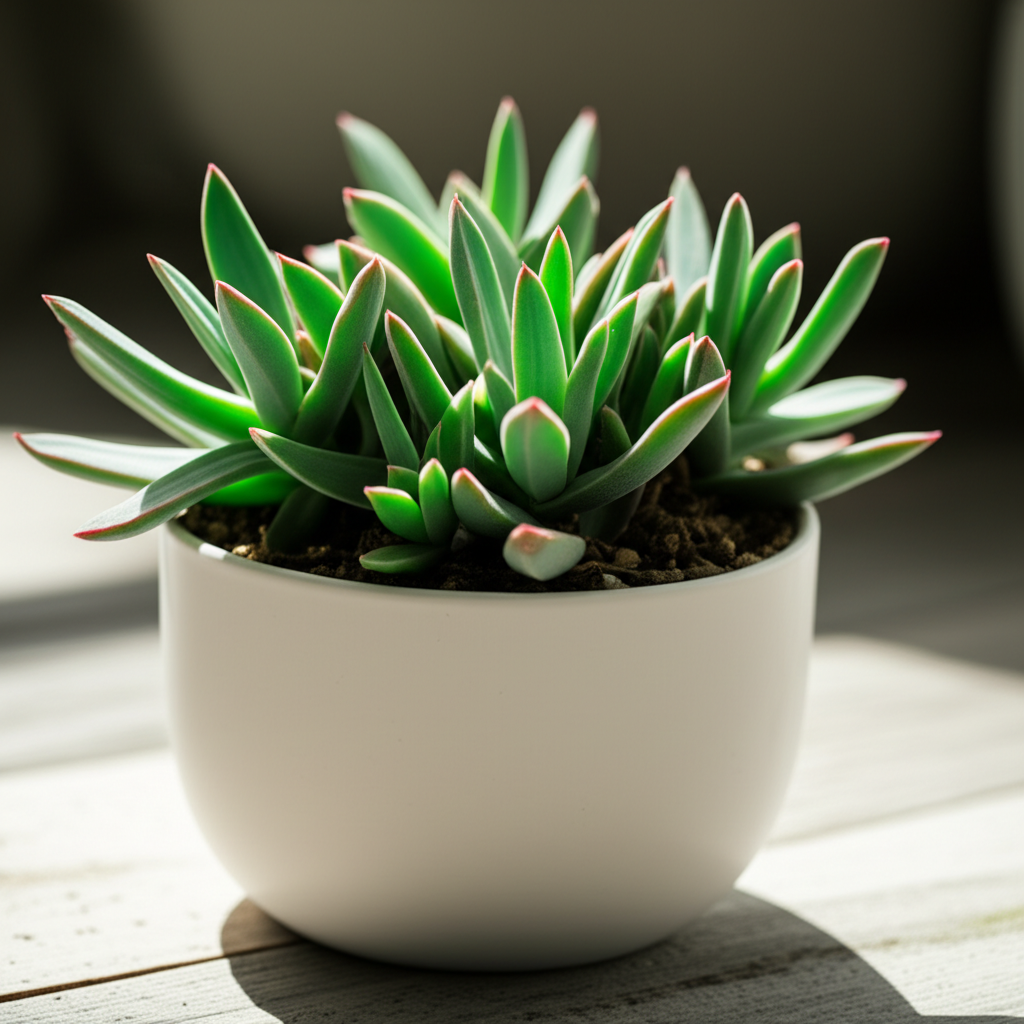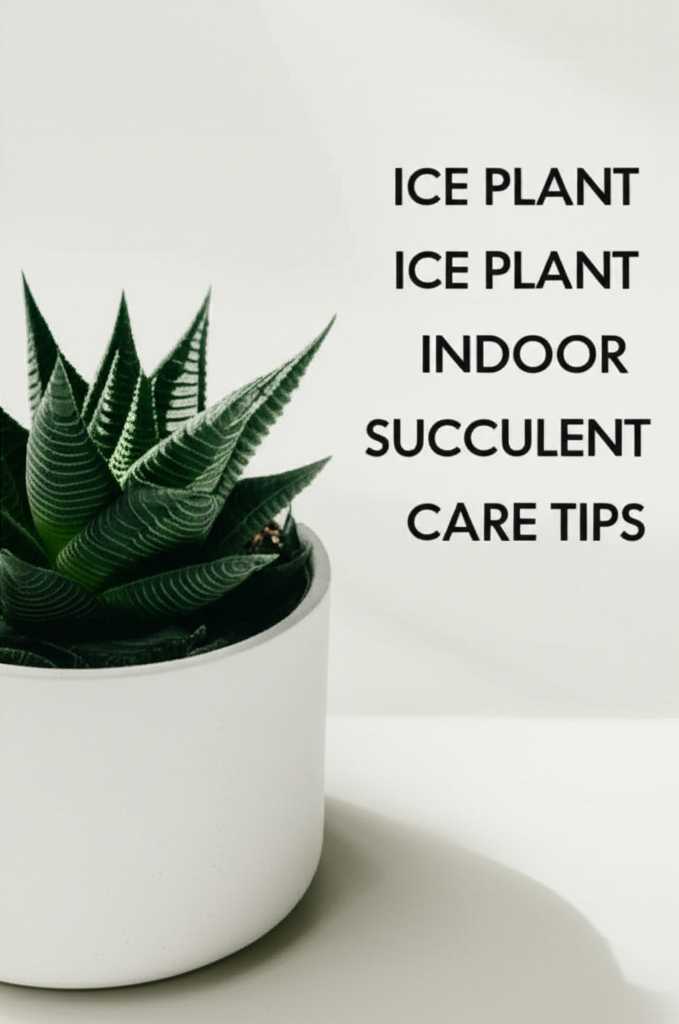Introduction to Ice Plant Succulents
Ice plant succulents, belonging to the Mesembryanthemaceae family, are a fascinating group of plants renowned for their unique, water-filled epidermal cells. These specialized cells, often referred to as “papillae” or “bladders,” give the leaves a translucent or glistening appearance, resembling frost or ice. This adaptation helps them to reflect sunlight, reducing water loss and protecting them from intense heat. While many ice plants are hardy groundcovers in warmer climates, several varieties have gained popularity as charming indoor succulents, bringing a touch of the extraordinary to home environments.
Their diverse forms range from low-growing, mat-forming species to more upright, bushy varieties. The foliage itself is a visual treat, displaying a spectrum of colors from vibrant greens to blues and purples, often with striking patterns or markings. During their blooming season, many ice plants produce an abundance of small, daisy-like flowers, adding another layer of beauty. For indoor enthusiasts, understanding their specific needs is key to cultivating these captivating plants.
Understanding the Ice Plant Succulent

The term “ice plant” is a common name that encompasses a broad range of genera within the Mesembryanthemaceae family, with the most commonly cultivated indoor varieties often originating from genera like Delosperma, Lampranthus, and Aptenia. These plants are native to arid and semi-arid regions of the world, particularly South Africa, where they have evolved remarkable strategies for survival.
Key Characteristics and Varieties
The defining characteristic of ice plant succulents is their succulent leaves, which are thick and fleshy, designed for water storage. The epidermal cells, as mentioned, are a defining feature, contributing to their unique texture and appearance. Beyond this, the varieties suitable for indoor cultivation often exhibit:
- Compact Growth Habits: Many are naturally smaller, making them ideal for windowsill gardens or desktop displays.
- Vibrant Floral Displays: While not all ice plants flower profusely indoors, many will produce a profusion of colorful blooms when conditions are favorable.
- Varied Leaf Shapes and Textures: From cylindrical to flattened, smooth to slightly bumpy, the diversity in foliage is substantial.
Table 1: Key Facts and Comparison of Popular Indoor Ice Plant Succulents
| Variety/Genus | Common Name | Leaf Appearance | Flower Color | Growth Habit | Sunlight Needs |
|---|---|---|---|---|---|
| Delosperma cooperi | Hardy Ice Plant (though many indoor varieties are less hardy) | Cylindrical, bright green | Vibrant magenta/pink | Spreading, mat-forming | Full sun |
| Lampranthus spectabilis | Spectacular Ice Plant | Triangular, fleshy, often grayish-green | Varies (pink, purple, orange, yellow) | Bushy, upright to spreading | Full sun |
| Aptenia cordifolia | Heartleaf Ice Plant | Heart-shaped, bright green | Small, yellow or pink | Vining, trailing | Bright, indirect light to partial shade |
| Pleiospilos nelii | Split Rock Plant / Living Stone | Thick, paired, triangular “leaves” resembling stones | Yellow or orange | Clumping, slow-growing | Bright, direct sun |
Essential Indoor Ice Plant Succulent Care
Successfully growing ice plant succulents indoors hinges on replicating their native arid environment as closely as possible. This means paying close attention to light, water, soil, and temperature.
1. Light Requirements
Ice plant succulents are sun-worshippers. Indoors, this translates to needing the brightest light available. Position your plants on a south-facing windowsill where they can receive at least 6-8 hours of direct sunlight daily. If natural light is insufficient, supplementing with grow lights is highly recommended. Insufficient light is a common reason for leggy growth, pale coloration, and a lack of flowering.
- Ideal Location: South-facing windows.
- Minimum Requirement: 6 hours of bright, direct light.
- Signs of Insufficient Light: Stretched stems, pale leaves, weak growth.
- Acclimatization: When moving a plant to a brighter location, do so gradually to prevent sunburn.
2. Watering Practices
Overwatering is the most frequent killer of succulents, and ice plants are no exception. Their water-storing leaves and adapted root systems mean they prefer to dry out thoroughly between waterings. It’s always better to err on the side of underwatering.
- Watering Frequency: Allow the soil to dry out completely between waterings. This could mean watering every 2-4 weeks, depending on the season, humidity, and pot size.
- How to Water: Water thoroughly until water drains from the bottom of the pot. Avoid misting, as this can promote fungal issues on the leaves.
- Signs of Overwatering: Yellowing or translucent leaves that feel soft and mushy, root rot.
- Signs of Underwatering: Wrinkled, shriveled leaves that feel dry.
3. Soil and Potting
The right soil mix is crucial for preventing waterlogged roots. A well-draining potting mix is paramount. Standard potting soil alone is too dense and retains too much moisture. You’ll want to create a mix that allows water to pass through quickly.
- Ideal Soil Mix: A cactus or succulent potting mix is a good starting point. You can improve drainage further by adding perlite, coarse sand, or pumice in a 1:1 ratio with the potting mix.
- Pot Selection: Use pots with drainage holes. Terracotta pots are excellent as they are porous and help the soil dry out faster than plastic or glazed pots.
- Repotting: Repot only when the plant has outgrown its current container, typically every 2-3 years, preferably in the spring.
4. Temperature and Humidity
Ice plant succulents thrive in temperatures that mimic their native environments. They generally prefer warm daytime temperatures and cooler nighttime temperatures, which can encourage blooming.
- Daytime Temperature: 65-75°F (18-24°C).
- Nighttime Temperature: 50-60°F (10-15°C) is beneficial, especially for encouraging flowers.
- Tolerance: They can tolerate higher temperatures if humidity is low and they are well-watered. Avoid prolonged exposure to temperatures below 40°F (4°C).
- Humidity: Low humidity is ideal. Avoid placing them in humid areas like steamy bathrooms. Good air circulation is important.
5. Fertilizing
Succulents do not require heavy feeding. Over-fertilizing can lead to weak, leggy growth. A light feeding during the growing season is usually sufficient.
- Fertilizer Type: Use a balanced liquid fertilizer diluted to half strength, or a fertilizer specifically formulated for succulents and cacti.
- Frequency: Fertilize once or twice during the spring and summer months. Do not fertilize during the fall and winter when the plant is dormant or growing slowly.
Propagation Methods
Ice plant succulents are relatively easy to propagate, allowing you to expand your collection or share with fellow plant enthusiasts.
Stem Cuttings
This is the most common and effective method for propagating many ice plant varieties.
- Take Cuttings: Using clean, sharp scissors or a knife, take stem cuttings that are at least 2-3 inches long. Remove the lower leaves to expose a portion of the stem.
- Allow to Dry: Let the cuttings sit in a dry, shaded place for a few days to a week. This allows the cut end to callus over, which helps prevent rot when planted.
- Plant Cuttings: Insert the callused end of the cutting into a well-draining succulent potting mix.
- Initial Watering: Do not water immediately. Wait about a week before lightly watering to encourage root development.
- Provide Light: Place the cuttings in bright, indirect light.
Seed Propagation
While more time-consuming, propagation from seed is also possible for some ice plant varieties.
- Sow Seeds: Sow seeds thinly on the surface of a well-draining succulent mix.
- Moisten Soil: Lightly moisten the soil.
- Provide Warmth and Light: Cover the pot with a plastic bag or lid to retain humidity and place it in a warm, bright location (indirect light).
- Germination: Germination can take anywhere from a few weeks to several months.
- Care: Once seedlings appear, gradually increase light exposure and reduce humidity by removing the cover.
Common Pests and Problems
While generally resilient, indoor ice plant succulents can occasionally face issues with pests or common succulent problems. Early detection and appropriate action are key to maintaining plant health.
Pest Infestations
The most common pests affecting succulents include mealybugs, spider mites, and aphids. These sap-sucking insects can weaken the plant and transmit diseases.
- Mealybugs: Appear as white, cottony masses, usually in leaf axils or along stems.
- Spider Mites: Tiny red or brown mites that spin fine webs, often on the undersides of leaves.
- Aphids: Small, soft-bodied insects, usually green, black, or brown, clustering on new growth.
Treatment: Isolate affected plants immediately. For mild infestations, use a cotton swab dipped in rubbing alcohol to dab the pests directly. For more severe infestations, insecticidal soap or neem oil can be used, following product instructions carefully. Ensure thorough coverage.
Root Rot
As previously emphasized, overwatering is the primary cause of root rot, a fungal disease that thrives in moist conditions. Damaged roots cannot absorb water and nutrients, leading to wilting and decay.
- Symptoms: Yellowing, wilting, mushy leaves, blackening at the base of the stem.
- Treatment: If root rot is suspected, carefully remove the plant from its pot. Trim away any black, mushy roots with clean shears. Allow the remaining healthy roots to dry out for a day or two before repotting in fresh, well-draining soil. Avoid watering for at least a week after repotting.
Leaf Drop or Yellowing
This can be caused by a variety of factors:
- Overwatering: Leads to mushy, yellowing leaves.
- Underwatering: Causes leaves to become dry, shriveled, and eventually drop.
- Insufficient Light: Can result in pale leaves and eventual leaf drop as the plant struggles to photosynthesize.
- Extreme Temperatures: Sudden temperature fluctuations can stress the plant.
Diagnosis: Assess your watering, light, and temperature conditions to pinpoint the cause.
Table 2: Ice Plant Succulent Care – Pros and Cons of Practices
| Practice | Pros | Cons |
|---|---|---|
| Watering Thoroughly, Allowing to Dry | Promotes healthy root development, prevents rot, mimics natural conditions. | Requires vigilance to ensure soil dries completely, potential for overwatering if not monitored. |
| Using Well-Draining Soil Mix | Prevents root rot, supports healthy root structure, improves aeration. | Requires purchasing or mixing specific ingredients, initial investment in components. |
| Providing Ample Direct Sunlight | Encourages compact growth, vibrant coloration, and flowering. | Can be challenging to achieve indoors without supplemental lighting, risk of sunburn if acclimated too quickly. |
| Fertilizing Sparingly in Growing Season | Supports healthy growth without promoting weak, leggy stems. | Requires knowledge of plant’s needs; over-fertilizing can be detrimental. |
| Using Terracotta Pots | Excellent drainage, encourages faster soil drying, promotes air circulation to roots. | Porous nature means more frequent watering may be needed in very dry environments; can break if dropped. |
Tips for Encouraging Flowering
While many ice plant succulents are grown for their foliage, their flowers are a spectacular bonus. Several factors contribute to successful blooming indoors.
- Consistent Bright Light: Ample sunlight is the most crucial factor for flower bud formation.
- Temperature Fluctuation: A distinct drop in nighttime temperatures, especially in late winter or early spring, can often trigger blooming.
- Proper Dormancy: Allowing the plant to experience a drier, slightly cooler period during the fall and winter months can help it store energy for flowering.
- Adequate but Not Excessive Water: Avoid overwatering during the dormancy period, but water lightly if the plant shows signs of severe dehydration.
- Patience: Some varieties may take a few years to mature before they begin flowering reliably indoors.
Conclusion
Ice plant succulents offer a unique and rewarding experience for indoor plant enthusiasts. Their captivating, ice-like epidermal cells, combined with their diverse forms and often vibrant blooms, make them stand out in any collection. By understanding and implementing their specific care requirements – primarily focused on bright light, judicious watering, and well-draining soil – you can ensure these fascinating plants thrive in your home. With a little attention to their needs, your indoor ice plant succulents will flourish, bringing a touch of desert wonder and a splash of color to your living space.


